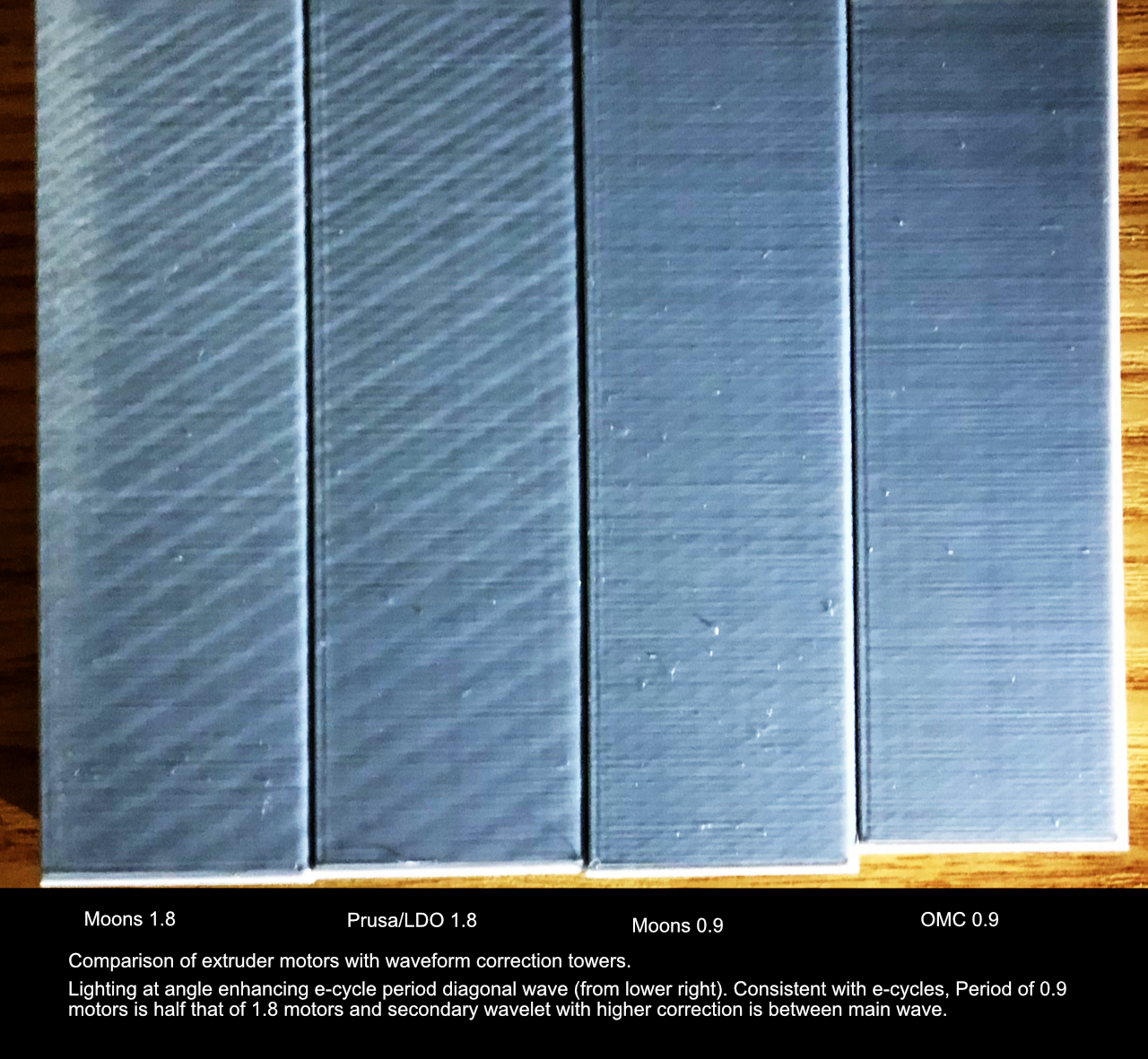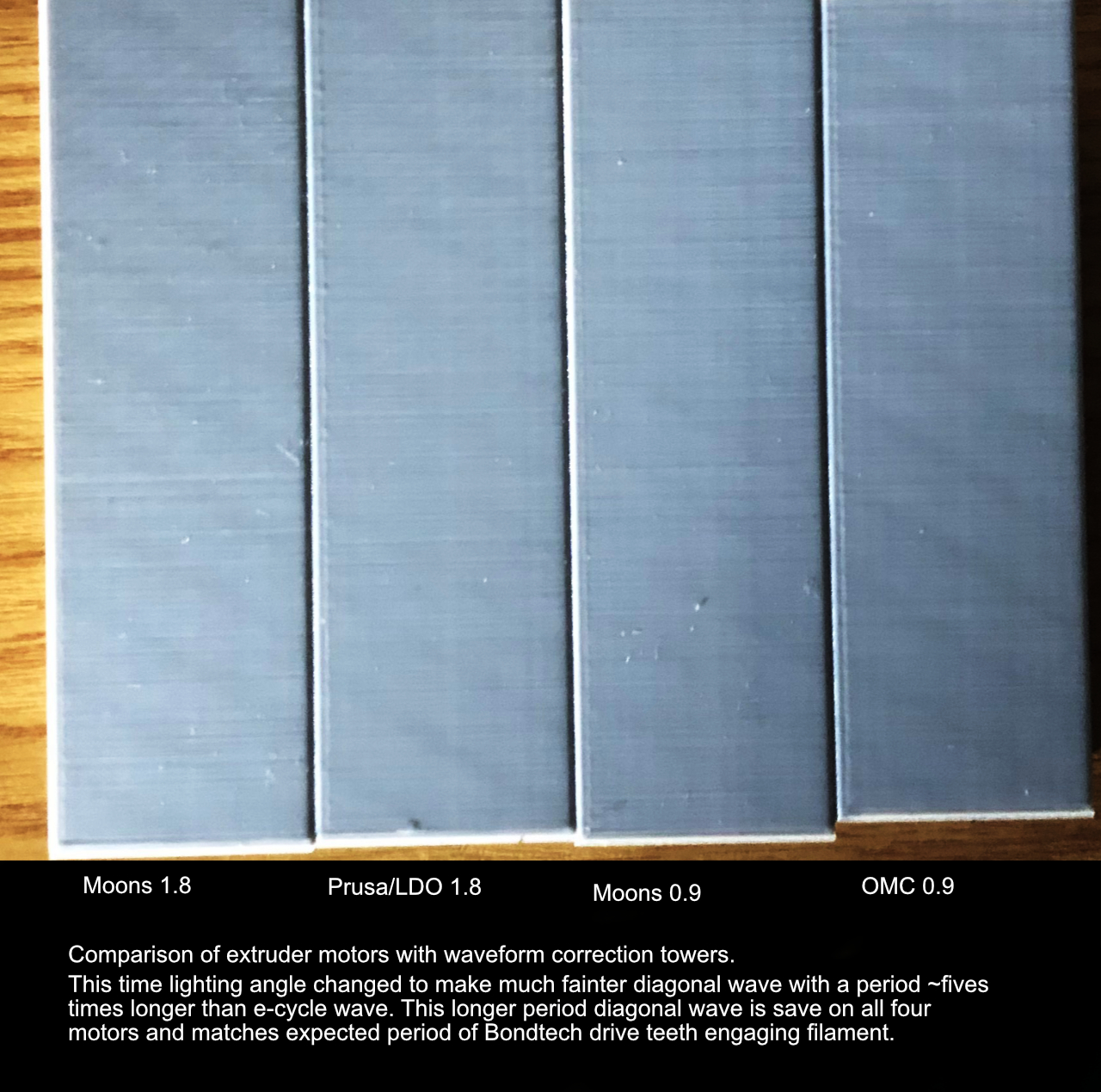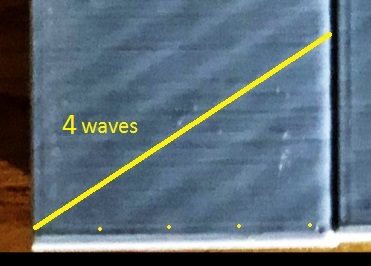Re: Trying to make sense of E (and X/Y/Z)-correction
Very little. The wave period matches the e-cycle, not shaft circumference. We can see that by the second wavelet induced with sine table alterations. It appears midway between the usually existing wave crests.
Yeah - thought of that after I posted. One turn of the shaft is a lot of material. Thanks though.
Regarding that second wavelet: I'd need to think about it for a bit, but you are adding a an exponential function to the correction table amplitude, right? Why would that be an even harmonic... rhetorical question to myself. I need to do some more reading on the TMC, and try to get a better understanding of it's intended purpose: and why it can cause multiple steps to occur when applied to a motion axis.
Re: Trying to make sense of E (and X/Y/Z)-correction
The wave table is stored as quarter waves and we actually have quite limited waveform shape range due to the compression scheme used by the TMC2130. I don't know the math well enough to explain why the power function creates the 2nd wavelet in the middle of the main wave, but I do know from my experiments with intentionally creating a middle of quarter cycle, discontinuity, that same midpoint spacing could be induced.
Lighting angle can bring out better observations of the towers. It should be tangential to the surface to bring out the waveforms.
I have adjusted gamma on these images to enhance wave visbility.
Here is with tangential lighting from lower right. This is at right angles to the extruder, non-monotonicity created diagonal wave. You see how the period is halved by going from 1.8 to 0.9 degree motors. Amplitude of the wave also decreases, but that is harder to see in photos. The secondary wave that is induce with higher power correction shows up in the middle of the main wave. You see that as you get higher on the towers.
Now I shift light to be from lower left, about parallel to the main diagonal wave. It's about 2.5 x the period of the e-cycle and much fainter. It is also the same on all four towers. That works out to 80/shaft rotation or double the Bondtech tooth pitch. Could this be the Bondtech drive teeth engagement?
If you are really paying attention, you can also see a 2 mm wide vertical pattern. That is the pulley/belt interaction. I've reduced that a fair amount by changing drive pulleys.
A couple findings are hidden in these test towers.
1. The stock Prusa/LDO 1.8 motor is nearly indistinguishable from the Moons 1.8 motor in terms of monotonicity in the extruder position.
2. Both 0.9 degree motors are more monotonic than the 1.8's. They have a finer wave, but more importantly a smaller AMPLITUDE wave.
3. OMC 0.9 degree motor did better than the Moon's 0.9 (If and only if the OMC 0.9 has linearity correction about 1.070)
Testing once more brings surprises.
I'm really shocked that the stock Prusa motor did so well that I had trouble distinguishing its tower from the 1.8 Moons. During VFA testing, the Moons' 1.8 were definitely better.
OMC 0.9 performance with linearity correction is also astonishing. What? A $20 motor beating the $55 Moons? Granted, that is only with linearity correction tuned. Probably need to recheck VFA's on y-axis WITH linearity correction and OMC 0.9.
Re: Trying to make sense of E (and X/Y/Z)-correction
I count 4.5 cycles on the extruder tests - left pair, first image, 2 cycles on the second image, the test you say is showing Bondtech tooth effect. I don't see the 5x ratio you are seeing. What am I missing?
Re: Trying to make sense of E (and X/Y/Z)-correction
I'm seeing a 2.5 : 1 ratio, not 5:1. That is what is perplexing. It's half what we should be seeing it at.
Several possibilities..
1. The longer period wave is not the bond tech teeth
2. The extruder motor wave is actually every half e-cycle.
3. The bond tech teeth are creating two changes/tooth
The first is hard to completely dismiss because of the numerical ratio being so simply related to the expect 5:1
The second is most possible. We glitch the quarter wave and in one e-cycle we do get two alignments of glitches in the two coil phases.
The third is really unlikely because I can't think of how a tooth engagement can create two changes. Maybe if the drive and idler gears were 180 degrees out of phase, but they are not. My tooth marks on filaments are directly opposed for the drive and idler sides of the filament.
Re: Trying to make sense of E (and X/Y/Z)-correction
I'm not seeing any secondary effects what so ever. And what's also a bit off is I see 6 cycles on my tower, not 4.5 like you have. Though, my layer height may not match what you used (I took the gcode from the Prusa page). And when I print the tower gcode you posted, I see zero diagonal pattern.
Re: Trying to make sense of E (and X/Y/Z)-correction
Layer height must be 0.2 mm, otherwise the trigger heights don't happen. The g-code looks for specific mm heights to perform the waveform changes. If layer thickness doesn't put a layer at those trigger heights, the waveform doesn't change.
Your not seeing any secondary effects gives me an idea. -- I wonder if I back off Bontech idler pressure to reduce depth of filament bite or increasing to get full depth bite will make a difference.
Re: Trying to make sense of E (and X/Y/Z)-correction
Oh good grief! The number of Bondtech teeth probably isn't 80. Depending on the picture I'm count from, it could be as low as about 64 teeth. That would change the expected ratio away from 5:1.
Have to go back and count on an actual gear - ugh! Those are tiny! Anybody already have an accurate tooth count?
Re: Trying to make sense of E (and X/Y/Z)-correction
Have to go back and count on an actual gear - ugh! Those are tiny! Anybody already have an accurate tooth count?
Not something I can answer. I tried counting the teeth on my bike's rear sprocket and kept coming up with a different number every time: and that was only 13 teeth (when I read it off the metal).
Re: Trying to make sense of E (and X/Y/Z)-correction
I guess I will pull on the microscope during next motor swap. Yes, really looking forward to counting those tiny, somewhere between 80 to 60 teeth.
I emailed support at Bondtech. Maybe they will tell us the count.
Bondtech came through
Bondtech replied!
Hi Guy and thanks for your message, on the drivegears you are referring to there is 43 individual teeths.
With best regards
Martin
Bondtech Support Team
That makes the ratio of full motor steps:bondtech teeth
200 : 43 = 4.65
On the prints I count across same distance (diagonal in square rather than straight across)
10.6 main diagonal wave : 4.6 second wave = 2.3
Recall that ....
1 full step is one quarter of an electrical cycle
1 quarter wave period = 1 full step
Therefore...
50 e-cycles/revolution
200 quarter waves/revolution
200 quarter cycles/ 43 = 4.65
That is double the ratio between the main diagonal wave and the faint second diagonal
I still think the faint wave IS the Bondtech teeth. It's too harmonically related to the expected ratio. I just can't figure out the 2x factor.
From my Trinamic tuning testing, glitching HStart of QUARTER waveform induces a wavelet halfway between the main diagonal waves. The diagonal wave is 1/4 e-cycle long or 1 step cycle.
Re: Trying to make sense of E (and X/Y/Z)-correction
Counting waves in the material: the 1.8 degrees parts you've posted, I get something around 4 waves across the base of the part. I'll call that the fundamental. Looking at the second set of images where you see another set of ripples, but flowing in the opposite direction, I counts something around 2 waves.
Considering the peaks of both "patterns" are aligned - it's my surmise that the backwards slant is nothing more than a visualization of the highest peaks of the fundamental.
Re: Trying to make sense of E (and X/Y/Z)-correction
I don't think we are going to agree on our analysis. I can get the harmonic relationship only if I restrict the wave count/distance to single digit precision. Also, the fundamental doubles in frequency in the 0.9 degree motor towers, but the faint wave that you identify as harmonically related remains the same across the four towers.
I'm going to print a wider e-core object to get more accurate wave period measurements.
Re: Trying to make sense of E (and X/Y/Z)-correction
The fact the 1.8, 0.9 both have "bright" or high peaks at the same "frequency" supports the idea these highest peaks may be visible when lit from a different angle. You have a primary frequency, which the 0.9 stepper doubles, but not in a pure distortionless form, so that the primary peaks remain the largest of the new "pair" of peaks. Think of lighting two mountain peaks, one slightly taller than the other, at a certain angle of sunlight, only the tallest peak will be lit.
So changing the angle of the light source is selectively highlighting the various "highest" peaks. My vote is if N=1.8 degrees, then we are seeing 2N (correction induced 2nd harmonic that comes and goes up the tower) and N/2 (subharmonic of uncertain cause).
As for better resolution of N, try making the tower taller rather than wider, with more and thinner layers.
And in any case, without some underlying math (which you may have done that I haven't done) - my notes here are opinion, not fact. 🙂
RE: Trying to make sense of E (and X/Y/Z)-correction
Hi guys, I read the whole thread and all I can think is "YOU Know nothiung Jon Snow!!" Lol Meaning I have understand all word but man, to fully understand the meaning of them all I am not sure LMAO .
But thanks for this interesting Thread. I was looking to understand more about the Linear Correction of the Extrude, see I have done some Extrusion calibration then Linear Calibration of the filament to get there personal k value. but I haven't done the Ecor tower Before... Should I do it or all calibration will need to be done again?
It's all in the name of knowing the machine/ having the best print possible!
Thanks!
RE: Trying to make sense of E (and X/Y/Z)-correction
You can pick and choose which cals to run. Mostly. lol. E-correction is a fine tune, if everything else is tip-top, you can see a small improvement. But anything not tip-top - like belts, bearings, nozzle condition, table strength, and your results may vary.



